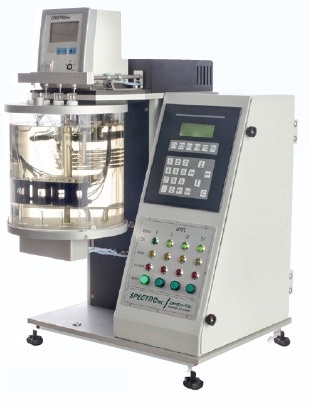Since it is essential to determine the viscosity of a lubricant for condition monitoring, field-based users require portable viscometers for the on-site evaluation of critical equipment. At present, solvents, temperature and density measurements are required for portable viscometer options. However, there is a difference between the field-based data and the laboratory-based data. Especially making precise viscosity measurements with in-use oils by any method is a challenge considering the presence of their particulates, combustion by-products, and water.
The Q3000 portable solvent-free viscometer from Spectro Scientific is a true kinematic heated field viscometer designed for condition monitoring. The instrument is based on the patented split cell capillary method, which helps in the simplification of viscosity measurement in Centistokes at 40°C. It exhibits an accuracy of 3% and reproducibility on an NIST-traceable viscosity standard. End users can use this field viscometer to compare its performance on viscosity measurements of used oils with conventional laboratory viscometers. There is a requirement for a method to determine the performance of a portable viscometer considering the specific requirements of users. This article discusses one such method and the comparison results of field viscometer with a laboratory system.
Procedure
In this method, a SpectroVisc Q3000 was used as a portable viscometer, while a SpectroVisc Q300 was used as a laboratory viscometer. The SpectroVisc Q300 from Spectro Scientific is a standard capillary tube viscometer engineered for laboratory analysis.

Figure 1. SpectroVisc Q3000

Figure 2. SpectroVisc Q300
Both devices were used for the viscosity measurements of a number of samples and the results were compared from instrument to instrument. Series-1 samples comprised entirely of NIST-certified standards, while series-2 comprised used oils. Each sample was run on each instrument three times with kinematic viscosity readings taken at 40°C.
Readings from each device were then averaged and compared. The use of NIST standards facilitates the accuracy of the two instruments being compared and to monitor the closeness of the results reproduced by the portable viscometer with those of the laboratory system. On the other hand, the used oil measurements are for immediate real-world results. It is not possible to make absolute accuracy comparisons without knowing the actual viscosities. If the readings from the two instruments are ‘close enough’ for the user, then it is possible to substitute the portable machine for the analytical instrument.
Results
The comparison of the performance of the Q3000 portable instrument with the Q300 bench-top instrument on a range of certified viscosity standards was illustrated in Figure 3.

Figure 3. Performance of Q3000 compared to SpectroVisc Q300 over range of certified viscosity standards. The Q3000 performs consistently across the calibrated range, with a relative standard deviation less than 2%
Table 1 provides the comparison of the Q3000 against the NIST references and Table 2 provides the comparison of the Q300 against the NIST references, while Table 3 provides the comparison results of the two instruments directly.
| TABLE 1 |
| Q3000 |
Ref |
% Diff |
| Q3000 |
Ref |
% Diff |
| 10.13 |
10.03 |
1.00 |
| 17.93 |
18.04 |
0.61 |
| 54.86 |
54.08 |
1.44 |
| 99.26 |
97.15 |
2.17 |
| 185.00 |
180.80 |
2.32 |
| 308.67 |
310.90 |
0.72 |
| Q3000 vs. NiST Standards |
| TABLE 2 |
| Q300 |
Ref |
% Diff |
| Q300 |
Ref |
% Diff |
| 10.02 |
10.03 |
0.11 |
| 18.06 |
18.04 |
0.09 |
| 53.79 |
54.08 |
0.54 |
| 96.64 |
97.15 |
0.52 |
| 180.93 |
180.80 |
0.07 |
| 314.90 |
310.90 |
1.29 |
| Q300 vs. NiST Standards |
| TABLE 3 |
| Q3000 |
Q300 |
% Diff |
| Q3000 |
Q300 |
% Diff |
| 10.13 |
10.02 |
1.11 |
| 17.93 |
18.06 |
0.70 |
| 54.86 |
53.79 |
2.00 |
| 99.26 |
96.64 |
2.71 |
| 185.00 |
180.93 |
2.25 |
| 308.67 |
314.90 |
1.98 |
| Q3000 vs Q300 |
The Q300 laboratory viscometer provided readings consistent with referenced ASTM norms (0.44%) for variation and the Q3000 provided readings within its 3% specification, while the comparison results of the two instruments, as shown in Table 3, were also within 3%. In the used oil comparison, Table 4 illustrates that the readings of the portable Q3000 were constantly within 3% of the Q300.
| TABLE 4 |
| Sample |
Q3000 |
Q300 |
% Diff |
| Sample |
Q3000 |
Q300 |
% Diff |
| Used Engine Oil |
54.56 |
55.24 |
1.22 |
| Used Engine Oil |
108.67 |
111.63 |
2.66 |
| Used Engine Oil |
132.00 |
128.80 |
2.48 |
| Used Process Oil |
158.33 |
161.80 |
0.98 |
| Gear Oil |
237.00 |
230.30 |
1.03 |
The presence of contamination in used oil can make repeatability beyond 5% between tests of the same sample. OEM engine and rotating equipment providers and users believe that viscosity variations above 10% from nominal values are the first evidence of possible problems. Hence, 3% is good enough in the perspective of users’ specifications. A portable viscometer is capable of immediately determining such problems, thus enabling improved decision making and effective preventive maintenance.
Conclusion
A portable viscometer, equipped with new solvent-free technology for on-site viscosity monitoring, can determine variations of in-use oil to indicate a potential problem at the equipment site.

This information has been sourced, reviewed and adapted from materials provided by AMETEK Spectro Scientific.
For more information on this source, please visit AMETEK Spectro Scientific.